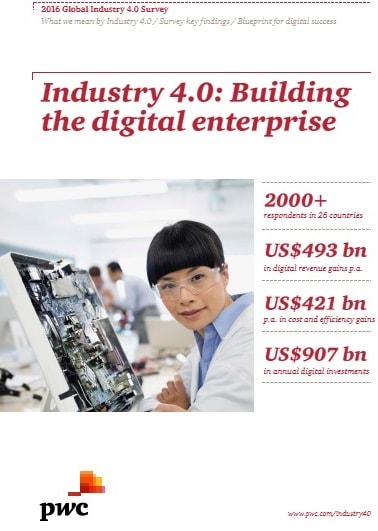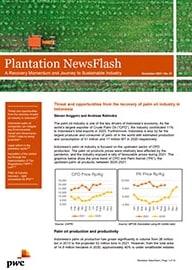Consumer and Industrial Products and Services Publications
General CIPS

April 2016
Industry 4.0 will revolutionise industrial production
Digitisation brings enormous benefits. Industrial companies expect to generate 3.6% p.a. in cost reductions over the next five years, driven by internal improvements and by working more closely across value chains. They’re also expecting to generate 2.9% p.a. in increased revenues by digitising products and services and developing new digital service offerings, all the way through to hosting platforms for industrial ecosystems.
Getting there won’t be easy. Companies will need robust data analytics capabilities; that will mean making significant changes. They’ll need to focus on developing the people and culture to drive transformation.
And it won’t come cheap. Investments in Industry 4.0 capabilities are expected to reach around 5% of annual revenues p.a. The good news: more than half of companies expect a return on investment within two years. And the payoff will potentially be enormous, as competitive landscapes get redefined.

Consumer products sector: Global tax rate benchmarking report
The report is a study of the key tax ratios of 55 of the largest companies in the global consumer products market. The analysis looks into the effective tax rate (ETR) and current tax rate reported by these companies, the trend over the last three years, and the drivers of the ETR. It also compares the ETR of US-based companies to non-US-based-companies, of "domestic" to "multinational" companies, and the ETRs of consumer companies to companies in other sectors.
Plantation

November 2021
Plantation NewsFlash - 2021: A Recovery Momentum and Journey to Sustainable Industry
In this issue we provide you updates on :
- Threat and opportunities from the recovery of palm oil industry in Indonesia
- Indonesian palm oil companies can mitigate key Environmental, Social and Governance (“ESG”) risks by being proactive
- Legal reform in the plantation sector
- Imposition of the carbon tax through the Harmonisation of Tax Regulations (“HPP”) Law
- Palm oil industry recovery – right momentum for IPO

December 2018
Plantation News - 2018 Update
In this issue we provide you updates on :
- Overview of palm oil industry landscape in Indonesia
- Online Single Submission (OSS) - New Digital Platform for Business Licenses
- Implementation of Indonesian Statement of Financial Accounting Standard ("PSAK") 69 "Agriculture" in the oil palm industry
- Highlights of the Tax Regulations Update
- Data Analytics, the first step towards better insight

August 2015
PwC Plantation Newsflash: Industry landscape regulatory and financial overview
In this issue we provide you with:
- Consideration surrounding mandatory use of L/C in Exports of CPO and CPKO
- Challenges faced by palm plantation companies
- Traceability, the first step towards sustainability
Retail & Consumer

April 2017
10 retailer investments for an uncertain future
2017 Total Retail report is focused on the kinds of investments retailers will need in order to thrive in tomorrow’s marketplace. This is the 10th consecutive year that PwC has published a study of online shoppers, and our sixth truly global study. This year we added several new areas of research, including Amazon’s impact and customers’ willingness to consider retailers as health care providers. We also delved into other research sources and included the insights of a number of PwC partners. The result? Ten areas where we believe retailers need to consider investing in to stay ahead of the competition.

April 2015
R&C worlds Express. Food trust: From compliance to competitive advantage
Recent food safety failures have spiked consumer concerns and prompted an escalation of regulations. The US Food Safety Modernization Act is a sweeping piece of legislation that will affect companies worldwide. This article discusses the issues and impacts on the industry and suggests actions companies can take to protect their brands.

February 2015
Total Retail 2015: Retailers and the Age of Disruption
What are the online shopping habits of consumers around the world? How can retailers adapt their operating models to keep pace with the demands of cross-border, multichannel consumers, and what are the complex tax issues they need to consider? Our consumer survey reveals some interesting findings.

February 2015
2015-16 Outlook for the Retail and Consumer Products Sector in Asia
This report discusses the outlook and trends affecting six retail and consumer product sub-sectors in Asia: food and general retail, fashion and apparel, online retailing, fast-moving consumer goods (FMCG), luxury brands and durable consumer goods and electronics. It focuses in particular on the key markets in Asia with further profiles of Indonesia. The report looks at the state of each sub-sector in 2014 and how the industry is expected to develop in the five years to 2018.

January 2015
18th Annual Global CEO Survey: Retail and consumer industry insights
Retail & consumer goods CEOs are less upbeat about the state of the global economy than last year, but they remain fairly confident in their ability to generate growth over both the short and mid-term. Both sectors are looking to the US and China for growth, followed by Germany for retail CEOs and Brazil for consumer goods CEOs.

November 2014
Connected and curated – Long live the store!
The rise of technology has meant a change of role in the store. Push has become pull. Necessity has become choice. Mass production has become custom, unique and personalised. Customers now drive retail and the traditional store, needs to adapt or die.

November 2014
Decision making in retail
How do retail executives weigh their options with so much on the line? Analytics can help executives make hard choices.

July 2014
R&C Trendwatch - Anticipating the rise of junk food and soda taxes in emerging markets
Governments in emerging markets are increasingly applying sin taxes on junk food and soda as a way of raising revenue - and responding to public health concerns. Companies wanting to determine where sin taxes may be introduced will want to consider the political debate over health in the country, whether there is a middle class engaged in the debate, as well as fiscal need.

July 2014
Fighting a growing threat: Retail and consume goods sector analysis of PWC’s 2014 Global Economic Crime Survey
Retail and consumer goods companies are experiencing greater levels of economic crime. Nearly half of respondents say their company has experienced this type of event in the last two years. By far the most commonly reported type of economic crime for the sector is asset misappropriation, while other common types of fraud included bribery and corruption, accounting fraud and cybercrime.

Consumer products sector: Global tax rate benchmarking report
The report is a study of the key tax ratios of 55 of the largest companies in the global consumer products market. The analysis looks into the effective tax rate (ETR) and current tax rate reported by these companies, the trend over the last three years, and the drivers of the ETR. It also compares the ETR of US-based companies to non-US-based-companies, of "domestic" to "multinational" companies, and the ETRs of consumer companies to companies in other sectors.
Contact us

















